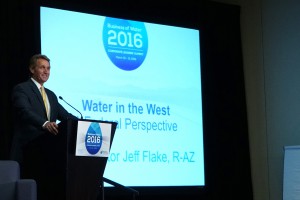- Slug: Water Summit, 815
- Photos available (thumbnails, captions below)
- Video available here
- Infographic: https://infogr.am/colorado_river_flows
By TRAVIS ARBON
Cronkite News
PHOENIX – U.S. Sen. Jeff Flake, R-Arizona, said he believes there is a chance the U.S. Congress will move forward with legislation addressing drought in the West, but any federal response to water shortages must not overrule state policies or rely on federal funding.
Flake spoke at the 2016 Business of Water Summit in Phoenix, where local government and business leaders convened to discuss the future of water sustainability in the Southwest. Attendees from Colorado, Arizona and California streamed into the Hyatt Regency Phoenix hotel for the two-day conference.
The Colorado River Basin faces a 16-year drought that has led to tightening belts as the swelling population of western states increases strain on the river’s resources.
According to the U.S. Census Bureau, the combined population of California, Arizona and Colorado has grown about 19 percent since 2000, from about 43.3 million to more than 51.4 million people. Meanwhile, the U.S. Department of the Interior said the Colorado River system – Arizona’s largest water source – is experiencing its driest period in the last 100 years.
Flake said he has been working on federal legislation to address the issue, but those measures remain trapped in congressional gridlock. One proposal would extend the Colorado River system’s conservation pilot program and allow the Department of the Interior to make voluntary agreements with water users to limit use. Flake said he is pushing for the Senate to advance a western drought bill this year, but the probability of passage remains low.
“I would say it’s somewhere around 40 percent chance right now,” Flake said. He added that there may not be enough time remaining in the legislative session to tackle the drought.
Ellen Hanak, the director of the Water Policy Center at the Public Policy Institute of California, said the federal government can do more to address western drought and water shortages. Her organization published a report in February on suggested federal responses.
The report recommends the federal government use its influence to resolve water conflicts, improve monitoring and data collection of water systems and develop plans to protect endangered species, among other reforms.
“A piece of the solution is reducing some of that (agricultural) water use, but to do that in a way that is not causing the kinds of problems you see,” Hanak said. “There are ways in which both local agencies and the federal government programs through (Department of Agriculture) can help to encourage more creative ways to do that.”
Flake said funding for federal legislation is complicated, because he would want to find ways to cut spending in other areas to pay for drought programs.
He said he would prefer to find a solution that honors previously negotiated water rights, including contracts that are nearly 100 years old, despite the potential for increased drought in the Colorado River Basin going forward due to climate change. A 2011 report by the U.S. Bureau of Reclamation projects temperatures in the Colorado River Basin to increase by 5 to 6 degrees fahrenheit during the century.
Although many of the contracts were negotiated decades ago, Flake said they have a provision for handling droughts – a shortage declaration – that would force states to reduce water use.
“Those things are going to kick in if we reach those levels, and we likely will,” Flake said. “It’s been postponed because of better rains last year, but it’s likely going to come. As far as new initiatives or new legislation, I don’t perceive that. I think it can be solved, for the most part, at the local level.”
Eric Kuhn, general manager of the Colorado River District, said the basin is entering a “new era” of water management.
“Today, we’re entering into a new era of uncertainty, and that uncertainty is because of the math,” Kuhn said. “We’re using too much water in the wrong ways. … I don’t want to say right or wrong from a moral standpoint, but from an economic standpoint.”
The math doesn’t work, Kuhn said, because the Colorado River in the 1920s was experiencing an unusually high flow. Water planning at the time did not take into account future supply decreases. But now, with rising population and changing climate, water use exceeds what the river replenishes.
Kuhn said excess usage is draining water stores built up over decades, and basin reservoirs have declined from 60 million acre-feet to 30 million acre-feet.
Marco Ugarte, sustainability manager at brewing company MillerCoors, said he doesn’t believe the lack of a federal response creates uncertainty for businesses – like his employer – that use high amounts of water, but he hopes policymakers listen to the concerns of the business community when making decisions about water reduction.
Some businesses, he said, might be more capable of making quick water use reductions than others, and each industry is different.
“Policymakers need to be aware of what is feasible, what is technically feasible, of the companies,” Ugarte said.
^__=

